Volume 3 Issue 1
Welcome to the ninth edition of Chromatography Today, and may I take this opportunity of wishing you all happy and prosperous New Year.
The theme of this edition is LC/MS, the key analytical technology which combines the physical separation capabilities of HPLC with the mass analysis capabilities of mass spectrometry. LC/MS with its very high sensitivity and specificity has now become the foremost tools for the characterisation and quantification and as can be see from the articles in this edition has a very varied and expansive applications base.
This technology not only has spawned many acronyms but can be held responsible for one of the most coined words in analytical development “hyphenation”. Back in the early 1980’s the challenge to marry a liquid stream with a gas phase technique carried out in vacuum became the major challenge for analytical scientists. Many novel approaches to solving this interface problem where explored, a number of which have now reappeared as potential solutions to some of the newer LC/MS problems of today. The discovery of electrospray ionisation marked the take off of the technique and when in the early 90’s the first bench top system arrived the technique began to stake a major foothold in industrial laboratories. It is now difficult to imagine a world without LC/MS, the technology which at one time was considered the sole domain of the expert spectroscopist has become a routine tool for all, -including chromatographers. The technology has been a major player in the growth of the global pharmaceutical Industry, becoming the technology of choice for pharmacokinetics, drug development, and regulatory control and with the advent of quality by design (QbD) is also finding a place in quality control.
We have seen it become an integral part of the move to “high throughput technologies” fostering the developments in informatics, and it has been seen to be a major contributor to the “omics” revolution – proteomics, metabolomics etc -supplying the need for high throughput and high information content analysis. In recent years we have also seen its acceptance as a technology of choice for both environmental, forensic and food analysis. Whilst there are still many challenges out there for the technique, it is one of the few existing technologies that can offer a solution to the measurement challenge of the lower and lower levels of detection
required for regulatory control.
Returning to home and The Chromatographic Society, this edition contains a meeting report from the “Advances in Gas Chromatography” meeting held at my home base of LGC in November, it was really heartwarming to see a full auditorium and experience active debate in what is often considered a mature technology. The Chromatographic Societies Spring meeting on “Current Method Development Strategies in Separation Sciences” kindly hosted by Merck Sharpe and Dohme at their Hoddesdon, Hertfordshire facility on 19/20th May is also previewed. The AGM of the Society also takes place during the meeting. By way of reminder, if you have not already done so it is now time to renew your Chromatography Society memberships for 2010, and also to say that we are looking for newer members to help on committees - any interest please contact alan.handley@lgc.co.uk.
Previous Digital Editions
Digital Edition
Chromatography Today - Buyers' Guide 2022
October 2023
In This Edition Modern & Practical Applications - Accelerating ADC Development with Mass Spectrometry - Implementing High-Resolution Ion Mobility into Peptide Mapping Workflows Chromatogr...
View all digital editions
Events
ACS National Meeting - Fall 2024
Aug 18 2024 Denver, CO, USA
Sep 04 2024 Chiba, Tokyo, Japan
Sep 04 2024 University of Warwick, Coventry, UK
Sep 10 2024 Rockville, MD, USA
Plastics Recycling World Expo Europe
Sep 11 2024 Brussels, Belgium














